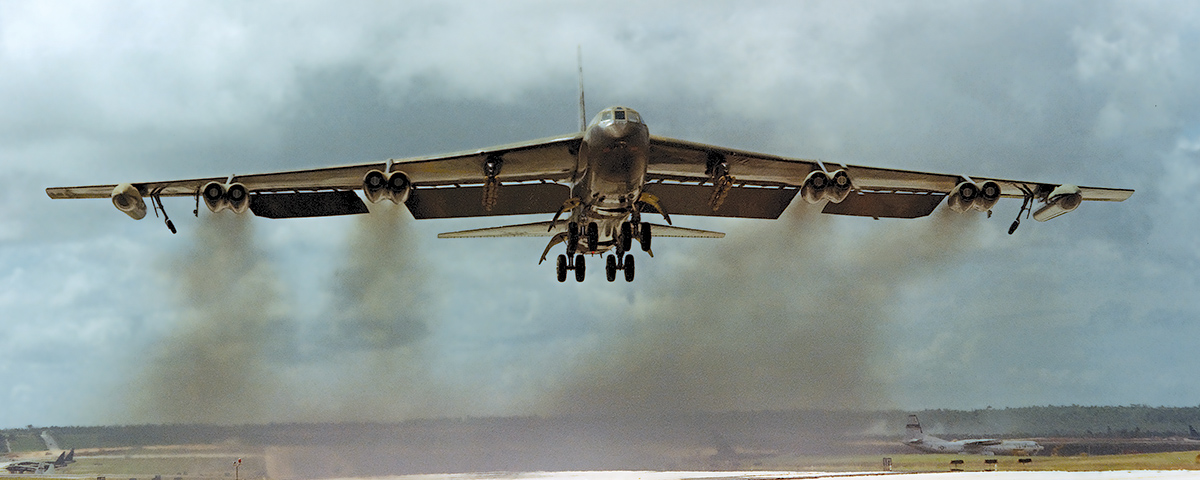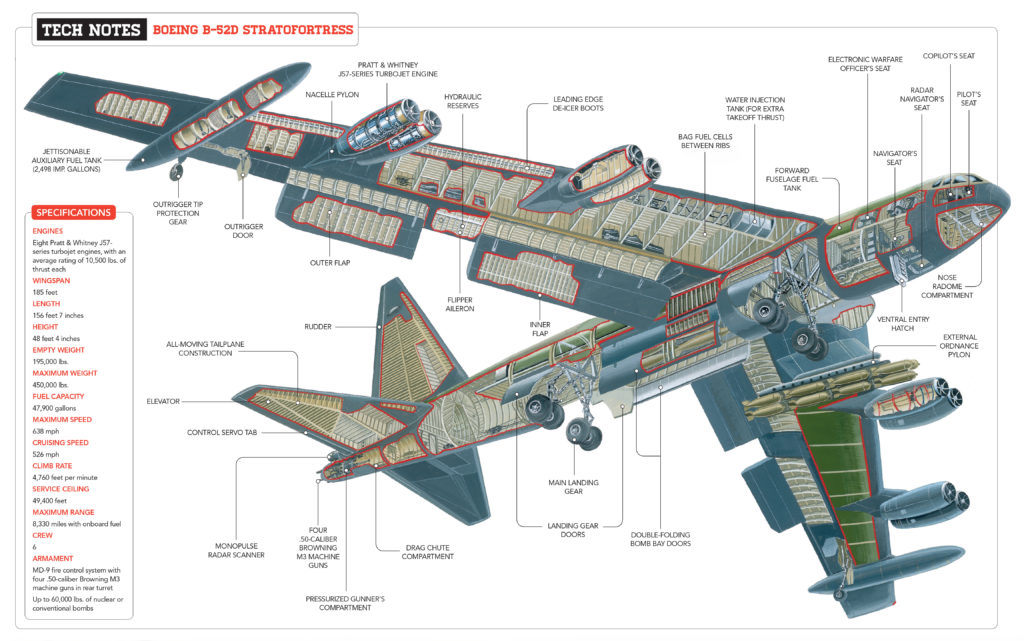Were it not for a 32-year-old U.S. Air Force colonel who happened to be an MIT-degreed engineer, the B-52 Stratofortress would have been a Tupolev Tu-95 Bear lookalike—a big, sweptwing bomber with four massive turboprops driving eight contrarotating propellers. That was the configuration Boeing’s engineers had settled on when they proposed to build the B-52. They pitched it to Colonel Pete Warden during an October 1948 meeting at a hotel in Dayton, Ohio, near the development and testing center at Wright-Patterson Air Force Base. “Get rid of those props or your proposal will be rejected,” Warden said, in what was in fact an overstepping of his authority. But Warden was a fan of turbojets and realized that despite fuel consumption problems and low power output numbers, jets were the future. He knew Pratt & Whitney was developing the J57 turbojet, which would change aviation history by powering both the Stratofortress and, as the civil JT3D, the 707.
It was a remarkable engine. Pratt had been excluded from jet engine development during World War II, since their piston radials were crucial to the war effort, but they had done enough fiddling on their own to come up with the 10,000-hp T45 turboprop, designed to be easily convertible into a pure jet. That conversion resulted in the J57/JT3D, one of the great turbojet engines of all time. Adding a fan to the J57 produced the TF-33, the low-bypass engine that ushered in the age of the fanjet. The ancient TF-33 would become the B-52H’s engine, today powering the only Stratofortresses that are still flying.
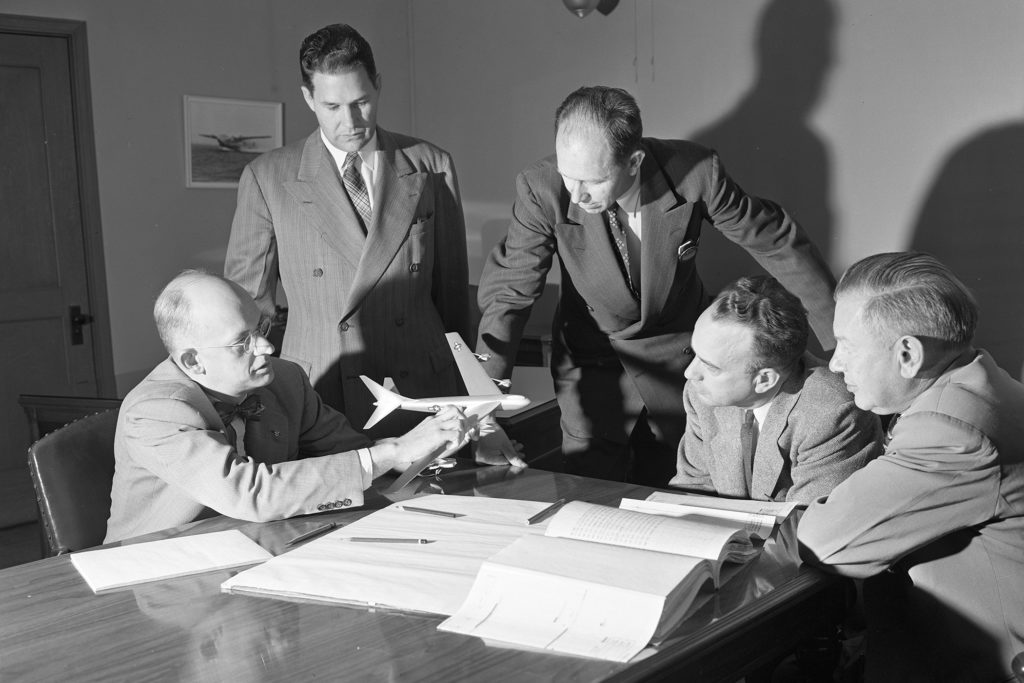
During a weekend thrash, the Boeing engineers reconfigured their proposal. Presented to the Air Force on Monday, the design featured eight turbojets paired in pods hung beneath swept wings. The proposal was buttressed by a silver-painted balsa model carved by Boeing chief aerodynamicist George Schairer. “We didn’t know what George was up to,” one of the engineers later said. “While we were running the numbers all weekend, George was off in a corner whittling away on his damn model.”
The B-52 first flew in April 1952, followed seven months later by the Soviet Tu-95. Both bombers are still in service, but the B-52 is currently scheduled to remain an active part of the U.S. Air Force inventory until 2050. No doubt at least one will continue to fly until April 15, 2052, if only on a ceremonial basis, to potentially make it the first aircraft, military or civil, to stay in active service for a full century.
Don’t count out the Bear. The Tu-95 is currently scheduled to remain in service until at least 2040, and if the Russians can find the spare parts to extend that, we have a horse race.
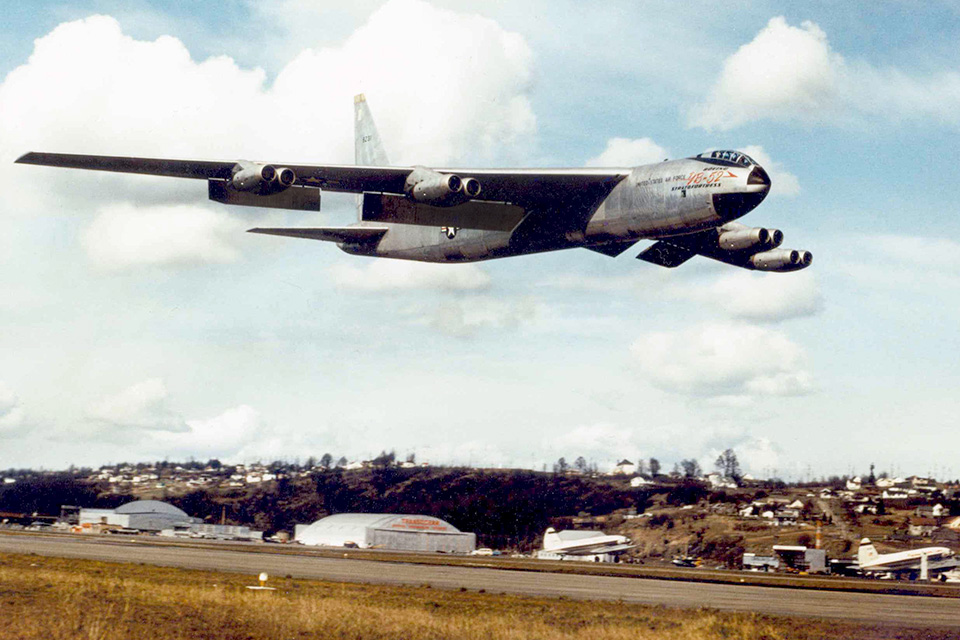
At one point, the Air Force began to doubt there was a need for the long-range, high-altitude B-52 bomber. Perhaps the Stratofortress should be developed purely as a reconnaissance airplane—an RB-52—leaving the offensive missions to Boeing’s never-built B-47Z Super Stratojet or a proposed sweptwing, eight-jet version of the Convair B-36. As it turned out, Boeing built 27 RB-52s, but they were basically just B-52Bs with bomb-bay fittings to accept a pressurized recon pod filled with electronics and a pair of lonely operators. Few would ever be flown with recon pods. All 35 B-52Cs were also pod-capable.
Development of the B-52 was a high-risk endeavor. Though the airplane was based in part on the roughly concurrent B-47 medium bomber, it was still an all-new airframe with an all-new engine, its operation dependent in large part on Boeing’s all-new flying-boom aerial refueling system. Yet incredibly Boeing, using 1940s and early ’50s technology and in only its second attempt to actually produce a jet, ended up designing one that nobody has yet been able to beat except in terms of largely useless speed and equally pointless stealth. Not the B-58 Hustler, the XB-70 Valkyrie, the FB-111, the B-1 or the B-2B. All are either out of business or soon will be, while the BUFF (“Big Ugly Fat F—er,” as it’s commonly known to its crews) soldiers on. Curtis LeMay famously said of the B-58 Hustler, “It’s a great airplane, if you’re going to war with Canada.”
So how did Boeing do it? By building a remarkably light yet simple and durable airframe with an enormous volume of internal space, allowing for continual upgrades through creative electronics, ordnance and equipment improvements. The B-52 began life carrying relatively primitive, high-maintenance, vacuum-tube navigation and bomb-aiming equipment. Some initially flew with no electronics at all, since the equipment was largely useless. Today, the BUFF carries the most sophisticated, computerized, 21st-century military gear available.
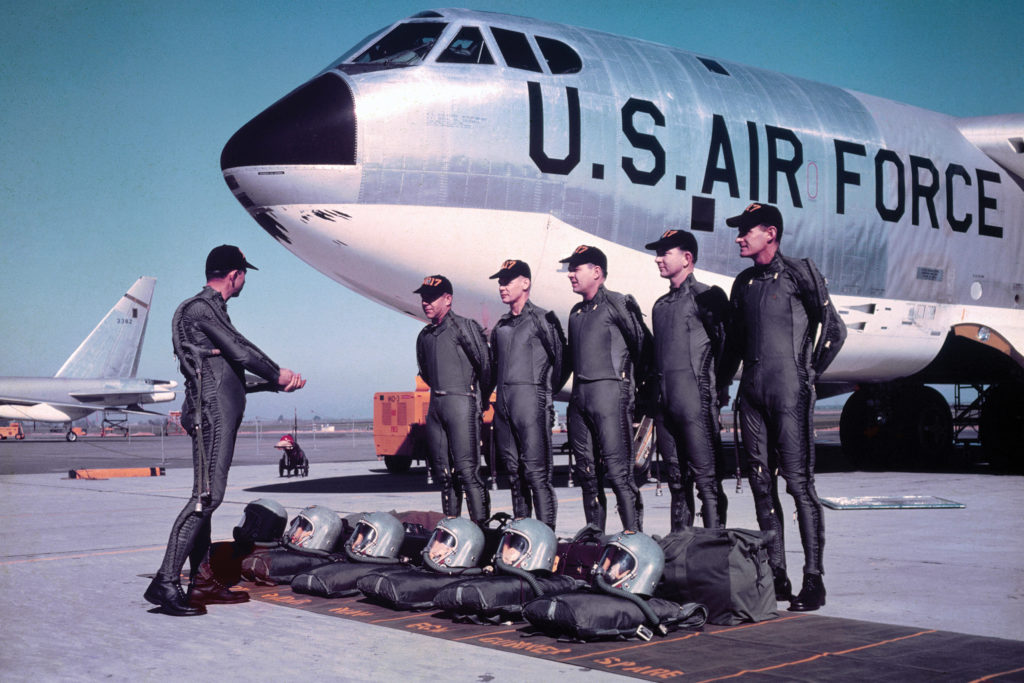
A fatal flaw of early B-52s—A through D models—was the airplane’s four big alternators. They were driven by turbines spun by engine bleed air and were inside the fuselage, directly under a fuel tank. Relief valves were supposed to vent overpressure in the bleed-air supply, but when they failed the alternators would overspeed and grenade, sending shrapnel into the fuel tank. Three BUFFs exploded in flight before this was corrected by installing straightforward shaft-drive alternators directly on the engines.
The B-52 was designed with a minimal rudder and small elevators, perhaps to prevent overstressing a somewhat delicate airframe (the bomber is limited to +2 Gs). The rudder constitutes just 10 percent of the vertical tail’s total area. Its ability to counter a crosswind is limited, thus the BUFF’s castering bicycle main gear: The airplane needs to be landed in a crab in a crosswind. Steerable through 20 degrees to each side, the gear angle is set during the approach. It works just fine, steering down the centerline while the fuselage is pointed at hangar row. B-52 pilots need to get used to landing while looking out the side windows.
Another B-52 “unusual attitude” is its takeoff performance. The BUFF’s wing is mounted at an eight-degree angle of incidence, in order to place the fuselage at a dead-level attitude during high-altitude nuclear drops—the type’s original mission. This also obviates the need for rotation on takeoff, which would be difficult with so much low-to-the-ground fuselage aft of the rear main landing gear. When a B-52’s up-canted wing generates enough lift for takeoff, the airplane simply levitates, initially climbing out with a slight nose-down attitude. This is the source, perhaps, of the claim that a B-52 doesn’t take off, it scares the earth away.
Landings are made equally flat and flare-free. With its huge Fowler flaps deployed, a B-52’s attitude on approach is virtually the same as in cruise.
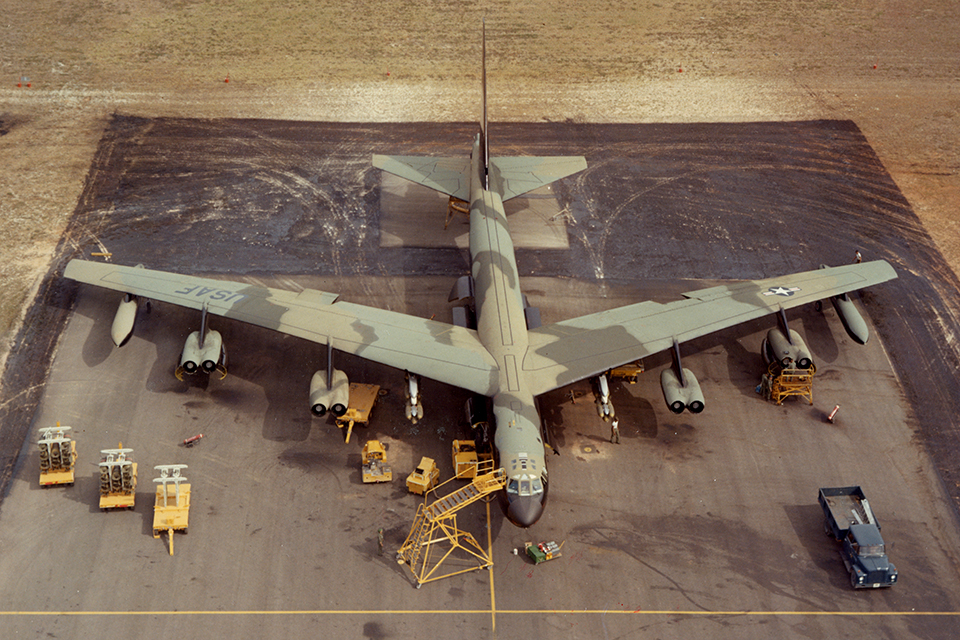
Elevator power didn’t become a problem until the B-52G and H went to wet wings rather than fuel cells. The new TF-33 engines spooled up rapidly enough that a firm push on all eight power levers, particularly on takeoff with partial fuel, sloshed the fuel load aft and there wasn’t enough elevator power to counteract the resultant nose-up pitch. The horizontal stabilizers were trimmable—the first to be used on an aircraft of this size—but several B-52s were lost to this flaw when pilots forgot to countertrim in advance against the pitch-up.
The B-52 turned out to be supremely capable in a role for which it was never intended: as a conventional bomber able to drop dumb bombs from high level or low. If not for that capability, the Stratofortress might have gone out of business by the mid-1960s, by which time the Soviets had developed anti-aircraft defenses—surface-to-air missiles (SAMs), interceptors, radar and other sensors—that made penetration of its borders by an enormous, unstealthy, subsonic bomber a fool’s errand.
As a result, the B-52 went to war for the first time against a tiny Southeast Asian country most Americans had never heard of, dropping World War II–style iron bombs on Vietnam and evoking comparisons to killing gnats with a sledgehammer. (B-52s have since seen action over the Balkans, Iraq, Afghanistan and Syria.)
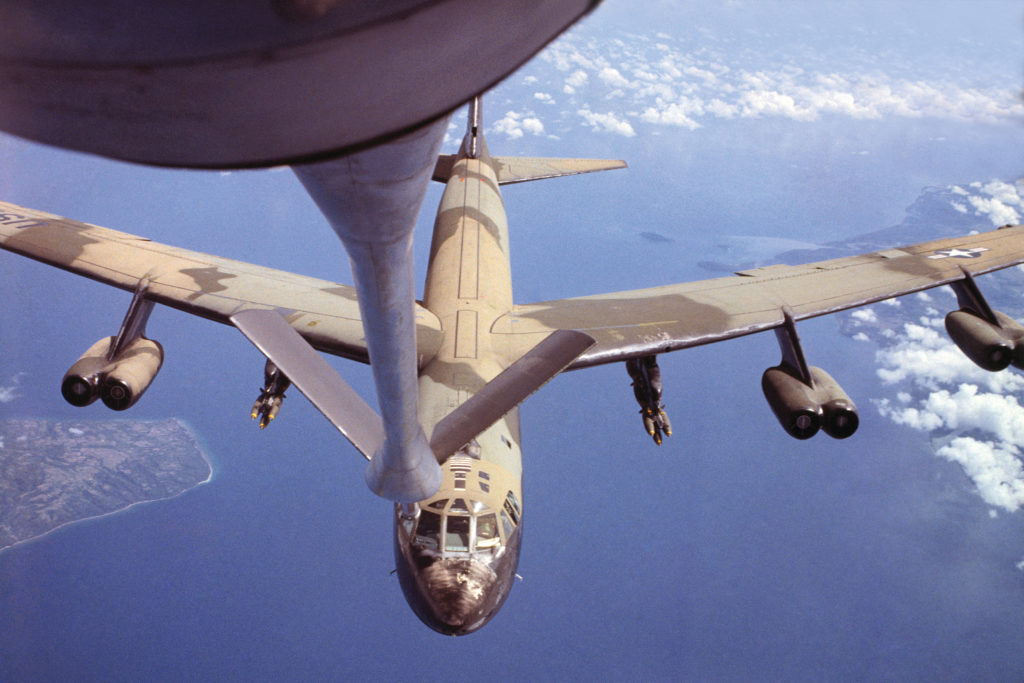
The BUFF’s combat debut in June 1965 was as awkward, ineffective and snakebit as that of any American airplane ever. Thirty B-52Fs took off from Guam in 10 three-aircraft cells on the first raid of Operation Arc Light. Twenty-six actually flew the mission, two of which collided while holding for aerial refueling, with the loss of both aircraft and their crews, and a third was lost when it was unable to find its tanker. The Viet Cong knew they were coming and had left for parts unknown.
Strategic Air Command was furious, for Curtis LeMay’s air force felt the BUFFs belonged to them, and not the USAF. SAC had seen its B-52s modified to carry cruise missiles, most notably the 5-ton, air-breathing Hound Dog, and this kept them in the role of nuclear deterrent. To use “their” airplane for what was considered close air support was ludicrous, some believed. What a strange role reversal: Tactical F-105 and F-4 fighter-bombers were attacking Hanoi on strategic missions while the world’s finest strategic bomber was flying tactical missions.
Many B-52 strikes over Vietnam were considered matchstick missions, good for nothing but converting jungles to splinters. Still, the North Vietnamese who did find themselves under a rain of 500- and 750-pound bombs found the experience to be terrifying. Each B-52 could carry up to 108 bombs, most of them internally but a substantial portion hung from the two underwing pylons. Each mission was on the one hand stunningly expensive—typically costing $20 million to mount—yet on the other performed by machines so completely amortized that the B-52 is one of the all-time weaponry bargains. Today, the B-52 is much like a used car that runs perfectly but is worthless for resale: reliable, cheap, efficient, familiar to both its drivers and maintainers, and with lots of spare parts available.
The B-52’s most prominent missions over Vietnam were part of Operation Linebacker II, when the bombers were unleashed for 11 days in December 1972 to crush Hanoi and the seaport of Haiphong. The devastation they wrought convinced the North Vietnamese to return to the negotiating table. Though the North ultimately won the war, at least the negotiations brought America’s POWs home and gave the politicians an excuse to withdraw and abandon South Vietnam to fight on its own.
Resistance to employing B-52s over Vietnam was initially based on the feeling that having a Stratofort shot down by the primitive North Vietnamese would be a PR disaster. By the time Linebacker II was over, the Air Force had lost 15 to SAMs (though the North Vietnamese claimed at least one fell victim to a MiG-21). Today, Northrop Grumman B-2s suffer a similar problem. Valued at roughly $2 billion apiece, the USAF’s 20 stealthy Spirits are simply too expensive to risk in operations against any enemy with sophisticated air defenses. The last of the B-2Bs will be retired by 2030…and the crews that deliver them to the Davis-Monthan Air Force Base boneyard may ride home in B-52s. Which is why some call the B-52 the Stratosaurus.
There have been B-52 models ranging from A to H, with plans currently being considered for a B-52J. (The Air Force doesn’t use the letter I, since it can be confused with the numeral 1.) But basically, there are two generations of Stratofortresses: the tall-tail B-52A through F, and the bobtail “Super BUFF” G and H, with a vertical fin a good eight feet shorter, in part as a weight-saving measure. The tall tail also reportedly caused induced turbulence at very low altitudes and reduced stability at high altitudes.
While other manufacturers were working on high-tech B-52 successors, Boeing refined the Stratofort to create the G model, armed with two Hound Dogs. Cruise missiles were an important addition to the B-52’s ordnance. Mounted on big external pylons under the wings, they allowed the bomber to stand off and launch its weapons from beyond the reach of SAMs and high-altitude Soviet interceptors—the weapons that had slammed the door on the BUFF’s access to Soviet airspace.
The Hound Dogs could also be fired up for takeoff assist, temporarily turning the B-52 into a 10-engine bomber. Their fuel supply could then be topped off from the BUFF’s own tanks.
Remarkably, the G model had both a lower empty weight and substantially higher takeoff weight—488,000 pounds, which is not even the most a B-52 can lift but simply the load limit of its landing gear and associated bulkheads.
Following in the propwash of the Boeing B-29 that toted Chuck Yeager and Glamorous Glennis to altitude for their Mach 1 dash, the B-52 enjoyed a storied half-century career as a mothership, carrying and launching a variety of experimental aircraft. Best known of these heavy lifters was NASA’s NB-52B “Balls Eight,” so nicknamed for its tail number, 52-008. Balls Eight and sister ship “The High and Mighty One” were modified to carry the North American X-15 rocket plane on a pylon outboard of the right wing root and also dropped a variety of other manned and unmanned lifting bodies and rockets.
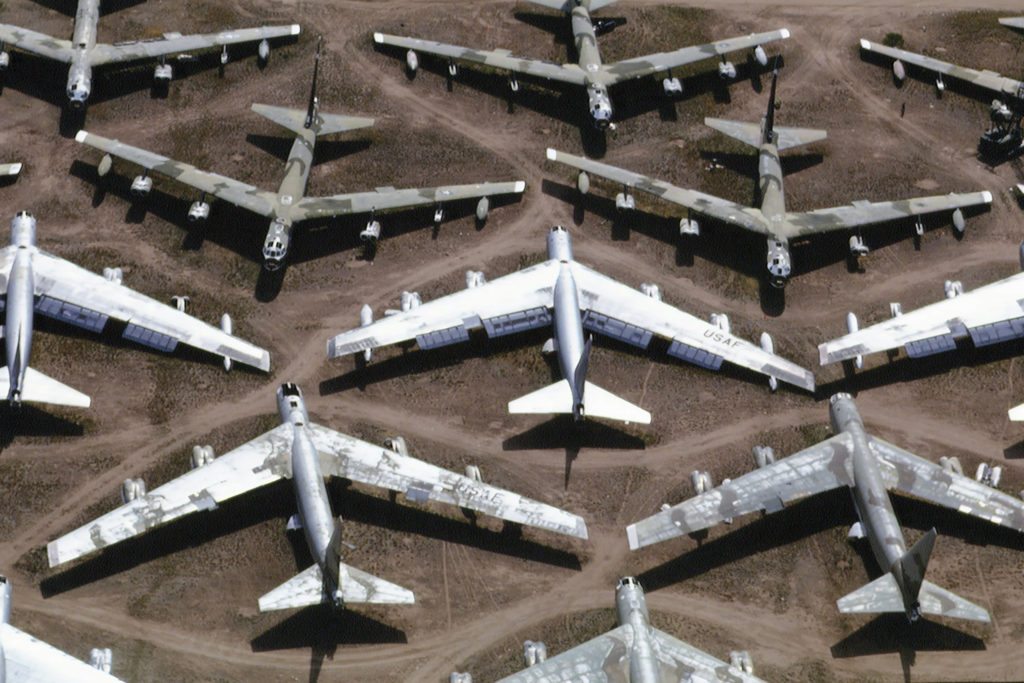
Today all the early B-52s are gone, boneyarded or crushed for scrap, save for those sent to museums. No B-52Gs are flying either. They were all sacrificed to the provisions of the 1991 Strategic Arms Reduction Treaty (START), which called for the scrapping of the entire B-52G fleet. This was done at Davis-Monthan, with the Gs clearly guillotined into pieces so that the destruction could be verified by Soviet satellites.
All that remains are 76 B-52Hs. At 240 tons apiece, they are the heaviest bombers of any air force ever to go into production. They have also carried the greatest-ever weapons load over the greatest range, and when a hypersonic cruise missile is finally ready for production, the H will carry it. A B-52H has already launched several scramjet-engine Boeing X-51A Waveriders, at least one of which achieved Mach 5.
The B-52 was the last American bomber to carry guns—four .50-caliber tail guns, succeeded by a multi-barrel 20mm Vulcan cannon in the B-52H. The Vulcans were removed from all of the Hs during the early 1990s. The tail guns had a limited cone of fire, but BUFF gunners supposedly shot down five MiG-21s over North Vietnam, though only two claims were ultimately confirmed.
Proposals to re-engine the B-52 stretch back to the late 1970s, when Rolls-Royce, Pratt & Whitney and GE suggested replacing its eight turbojets with four more powerful and fuel-efficient RB-211s, PW2000s or CF34s. The Air Force discounted the fuel-efficiency argument, saying that jet fuel was cheap enough that the cost was irrelevant. They forgot to allow for the fact that by the time a gallon of JP-4 is flowing out of a tanker’s boom, it has cost 15 times its original expense to get it there.
Re-engining a Boeing airliner is relatively easy: Find a carrier that wants Rolls, GE or Pratt engines; do the necessary engineering; flight test and you’re good to go. The military poses an entirely different problem: By the time you have convinced Congress to fund the re-engining of a bomber and then jumped through the required bureaucratic hoops, the engine you’re finally bolting in place is already two generations old. And bolting far more powerful engines onto a B-52 is not a trivial matter. Losing an individually podded, 60,000-pound-thrust outboard engine on takeoff would require far greater control authority than a Stratofortress’ vertical tail could currently provide, for one thing. For another, ground-clearance issues would have to be dealt with, as would the added stresses imposed on the wings.
America’s B-1s and B-2s are boutique bombers: expensive and limited in number. They are undeniably faster and far stealthier than the BUFF, but the B-52 can carry more weapons and is much cheaper and more reliable to operate. The Stratoforts are funded through 2050, at which point they will be anachronisms as baffling as seeing Lafayette Escadrille Spads on a flight line chocked next to F-22s and F-35s today.
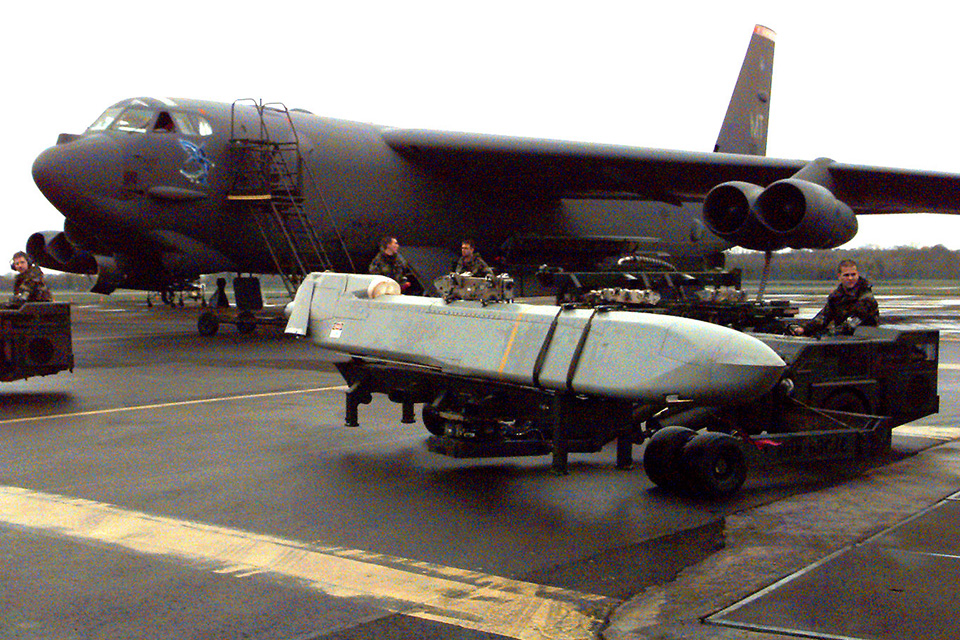
The B-52’s secret is its flexibility. It has always managed to find a role to play no matter how many times the script is rewritten, whether as a nuclear deterrent, carpet bomber, cruise-missile platform, low-level penetrator, smart-bomb dispenser, close air supporter, Terror of the Taliban or, soon, an arsenal aircraft. And it can still carry nukes. B-52s are like tanks: They do their best work where neither speed nor stealth is required. Once the fast movers establish air superiority, the B-52 can do its job quite comfortably.
The B-52J arsenal aircraft will be a high-capacity magazine, a “missile caddy,” for its companion F-22s and F-35s. In order to stay stealthy, those fighters won’t be able to carry external ordnance. The J, however, will have external stores galore, and will use them to blast a path through enemy defenses for the attack aircraft to follow. The arsenal aircraft will also be able to use those fighters as forward sensors and targeting nodes, so it can do the attacking itself. The big bomber’s enormous internal capacity will allow it to carry a war room’s worth of moving maps, next-generation avionics and a full suite of radar-jamming electronics plus digital datalinks to all other aircraft in its strike package. It’ll also be loaded with Mach 4, fire-and-forget AMRAAMs (advanced medium-range air-to-air missiles), making it in effect an offensively and defensively armed AWACS (airborne warning and control system).
In the words of ex-B-52 command pilot and Aviation History contributing editor Walter Boyne, the B-52 is “the single most important aerial weapon ever developed by any air force…. Never in the history of modern warfare has a major element of national defense been so long-lived.” (Boyne wrote this when the B-52 was a mere 39 years old, not even middle-aged yet.) It is also one of the very few American weapons that has never been provided to any ally.
The BUFF, neither ugly nor fat, will forever stand amid the pantheon of truly great aircraft, its vast wings sheltering the Wright Flyer, DC-3, Spitfire and a few other all-time classics. None, however, will outlive it.
Contributing editor Stephan Wilkinson recommends for further reading: Boeing B-52: A Documentary History, by Walter J. Boyne; B-52 Stratofortress, by Robert F. Dorr and Lindsay Peacock; B-52 Stratofortress, by Bill Yenne; and Boeing B-52 Stratofortress, by Peter E. Davies and Tony Thornborough.

